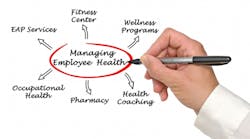4 Strategies for Getting Manufacturing Workers to Engage In Wellness
Even in an industry being transformed by automation, next shoring, and the Internet of Things (IoT), your most important asset is still people. And health is at the top of their priority list.
As healthcare costs grow faster than incomes, your benefits program has to do more than motivate 10,000 steps per day. One out of every two people is walking around with a largely preventable chronic health condition, bloating 80% or more of U.S. healthcare spending.
Despite terabytes of data generated by health monitoring tools such as Fitbits and Apple Watches, workers still lack the insight and guidance they need to help them manage their health and lower their healthcare costs.
Do you have a corporate wellness program and are you measuring its impact? Fewer than half of workers stay engaged in their wellness program throughout the entire year, and just 38% say their program helps them manage healthcare costs.
Wellness can do better.
In fact, it can change lives.
If you want to grow your staff’s engagement in health and transform your wellness program into success stories, start by helping your people understand the big picture of their health and benefits. Next, motivate them to manage their health with personalized guidance and incentives.
Here are four strategies for getting your employees to engage in wellness:
- Capture and apply clinical data to detect risk
Less than one-third of workers know at least one of their key health facts—indicators of risk for chronic illness—and 37% don’t know what cancer screenings they need. Workers can’t address what they don’t know. Improving knowledge of personal health information is the first step in managing health.
Since one out of every two Americans suffer from a chronic condition, according to the Centers for Disease Control and Prevention (CDC), putting clinical information into people’s hands can help alter or prevent a lifetime of disease. Plus, it can have a significant impact on productivity and presenteeism.
That means arming your workers with more than lifestyle and activity information. Comprehensive health data is the foundation of successful wellness programs, and includes medical claims, pharmacy claims, biometric and lab results, activity tracker data, smart scale data, and more. Moreover, all of this data should be automatically updated daily and continuously throughout the year, so that workers spend minimal time chasing down or manually inputting information.
- Offer personally relevant recommendations to monitor and improve health
Even though most workers feel they have access to their health information, the majority don’t find it meaningful. Fifty-three percent feel it’s not so easy to understand their personal health information and/or understand what they need to do to maintain or improve their health.
Make sure your wellness program is doing more than just collecting data. Help your workers identify preventive needs and health risks. Most workers want help from their employer in setting personal health goals, so provide tailored health actions and recommendations to get each individual to where they want to be. Recommendations should include preventive care, condition-specific care, medication adherence and healthy lifestyle actions.
Implement regular updates on health conditions and health progress. Send reminders about critical health actions such as prescription refills and annual health exams.
If your program doesn’t include disease management, consider adding it. According to a 2014 RAND study, disease management can deliver 74% greater ROI per member than lifestyle management, and more than half of workers want incentives for medication adherence. Finally, help your employees track their goals weekly or daily. This way, your program becomes a personal health assistant, relevant and vital to each individual.
- Provide meaningful incentives seamlessly integrated with benefits
Merely having a wellness program isn’t enough to get people to use it; a spoonful of sugar helps the medicine go down. Eighty percent of consumers want incentives for wellness. In fact, our research shows that both rewards and disincentives—carrots and sticks—are key to consumer engagement. For example, 63% of workers say that colleagues who smoke tobacco should pay more for their healthcare.
Because people rarely make health choices without considering cost or coverage, be sure your program is tightly integrated with your benefits plan in order to drive up usage. Employees will more readily utilize tools that provide health recommendations within the context of benefits. Offer instant, automatic access to deductible status, out-of-pocket tabs and certification and authorization requirements.
Eight-six percent of consumers say it’s important to compare costs before procedures, but only 36% price shop before spending on healthcare. Providing a price transparency tool to help consumers look up doctors and procedures ahead of time and compare costs and quality ratings will add huge value to your program, and help your workers save money.
- Make wellness automatically accessible anytime, anywhere
Do your employees have to look in multiple places to see the big picture of their health? Instead, give them a one-stop shop, with a single dashboard view, available anytime on any device, and watch utilization increase.
Eighty-eight percent of workers say it’s important to have a single login for access to health information. Another 80% desire concise summaries and visual graphics when looking at health information. Finally, give them a way to easily ask for, share and update their information when on the go, including access to a health coach and/or searchable information from leading health organizations. Bonus: include a tool that lets them share information with their provider(s) when on the go.
You can’t automate or outsource better health, but you can inspire and shape it. You empower your people with the right tools to do the job. Now, empower your people with their health information, help them understand why it’s important, and give them the guidance and incentives to manage their health. This will help you create sustainable engagement in wellness. And sustainable engagement can lead to more than just healthcare cost savings—it can change lives.
Bryce Williams is a leader and pioneer in healthcare consumerism. His extensive industry experience includes leading the largest private Medicare health insurance exchange at Towers Watson. Bryce was honored in 2011 as the Ernst & Young Entrepreneur Of The Year for Northern California in Business Services.




